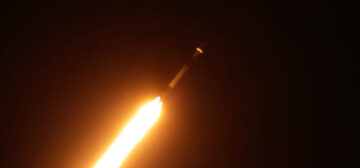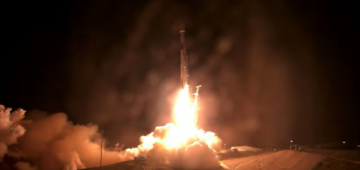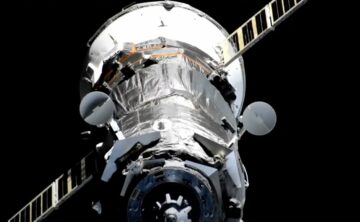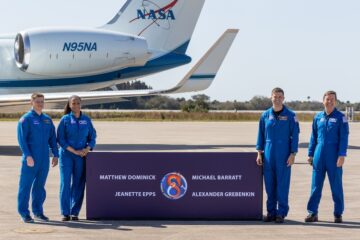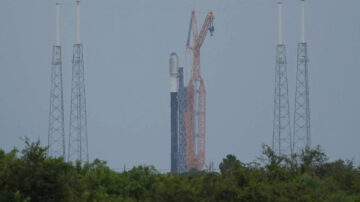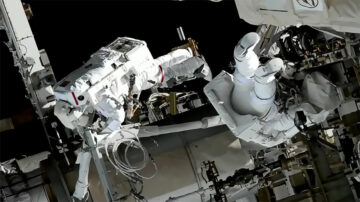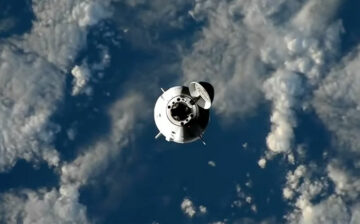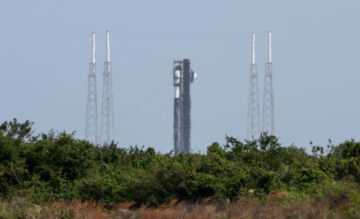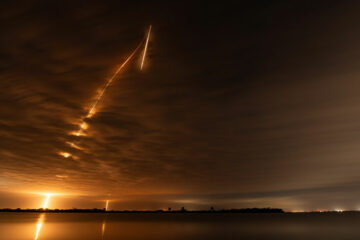
Virgin Orbit delivered seven small CubeSats for NASA, the U.S. military, Spire, and the Polish company SatRevolution into orbit Thursday with its air-launched rocket after release from a jumbo jet off the coast of California.
The launch marked the third successful flight in a row for Virgin Orbit’s LauncherOne rocket, a two-stage, liquid-fueled rocket sized to haul payloads up to 1,100 pounds (500 kilograms) into a low-altitude orbit.
Virgin Orbit’s ground team filled the rocket, mounted on a pylon under the left wing of its Boeing 747 carrier jet, with kerosene and liquid oxygen propellants at Mojave Air and Space Port Thursday before clearing the aircraft for takeoff.
The jumbo jet departed Mojave at 1:39 p.m. PST (4:39 p.m. EST; 2039 GMT) with a crew of four on-board, then headed west before turning south to fly over the Pacific Ocean.
Pilots Eric Bippert and Mathew “Stanny” Stannard guided the 747, named “Cosmic Girl,” on a southeast heading southwest of the Channel Islands to line up with the rocket’s intended flight path.
Two Virgin Orbit launch engineers — Sarah Barnes and Bryce Schaefer — were also aboard the Cosmic Girl carrier jet to verify the LauncherOne rocket was ready for release about 210 miles (340 kilometers) west of San Diego.
After final pre-launch checks, Stannard sent the command in the cockpit to release the 57,000-pound (26-metric ton) launch vehicle at about 2:53 p.m. PST (5:53 p.m. EST; 2253 GMT). Stannard has been assigned to Virgin Orbit to train for future launches based out of the United Kingdom.
Five seconds after dropping from the 747’s left wing, the rocket ignited its NewtonThree first stage engine and began pitching up to climb into space.

The kerosene-fed NewtonThree engine throttled to produce more than 73,000 pounds of thrust for three minutes, before shutting down and separating, allowing the second stage’s NewtonFour engine to take over.
The rocket then jettisoned its payload fairing after soaring above the discernible atmosphere, and the second stage shut off nearly nine minutes into the flight as it reached a preliminary elliptical parking orbit.
The second stage later reignited for about four seconds, placing the rocket into a 310-mile-high orbit inclined 45 degrees to the equator. The seven CubeSats on-board the rocket deployed around 55 minutes after launch.
The satellites included four nano-spacecraft flown under a contract with the U.S. military’s Space Test Program, which designated the mission STP-27VPB.
Those payloads were Globalstar Experiment And Risk Reduction Satellite 3, or GEARRS 3, designed to test connectivity between a CubeSat and the commercial communications network operated by Globalstar. That mission is led by the Air Force Research Laboratory.
Two small satellites funded by NASA were also among the payload package booked by the military’s Space Test Program. They included TechEdSat 13, a three-unit CubeSat the size of a shoebox, from NASA’s Ames Research Center.
TechEdSat 13 hosts several experiments, including an artificial intelligence and machine learning module with a neuromorphic processor designed to execute algorithms in a way that mimics the human brain. The spacecraft also carries an “exo-brake” device that will deploy to help the satellite generate atmospheric drag, allowing TechEdSat 13 to drop out of orbit faster.
The atmospheric brake technology could be used in future small satellites to help ensure they can de-orbit after completing their missions, preventing the creation of unnecessary space junk.
The Pathfinder for Autonomous Navigation, or PAN, mission consists of two CubeSats, each the size of a loaf of bread, that will attempt to dock together in orbit. It’s the first CubeSat mission to attempt an autonomous rendezvous and docking.
The project is a partnership between NASA and Cornell University. NASA, in a statement on its website, said the PAN mission is “one of the most advanced autonomous CubeSat systems that has flown to date.”
The PAN CubeSats have a cold gas propulsion system and reaction wheel attitude control devices, according to NASA. The docking experiment is expected to occur a few months after launch, with the CubeSats using GPS navigation to position themselves with an accuracy of several centimeters.
Three commercial satellites were also on Virgin Orbit’s rocket Thursday.
One of them, named ADLER 1, is a CubeSat designed to measure the space debris environment in low Earth orbit. The spacecraft hosts a short-range radar and a deployable piezoelectric array to detect and register space debris fragments, helping scientists verify models of the distribution of space junk in orbit.
The ADLER 1 mission is a partnership between Spire, a commercial satellite company, Findus Venture, and the Austrian Space Forum.
The Polish company SatRevolution had two satellites on the mission. One, named STORK 3, will join SatRevolution’s constellation of Earth-imaging nanosatellites.
The other one is named SteamSat 2, and is a partnership between SatRevolution the British space propulsion firm SteamJet. SteamSat 2 will test a water-based thruster designed to change the altitude or inclination of small satellites.

Virgin Orbit, founded by billionaire Richard Branson, is one of numerous companies competing in the cramped small satellite launch market. Other new launch industry entrants that have flown similarly-sized rockets include Rocket Lab, Firefly Aerospace, and Astra. Companies like Relativity and ABL Space Systems say they expect to launch their small-to-mid-size launchers for the first time this year.
The first LauncherOne mission in 2020 failed during the rocket’s first stage burn. Since then, Virgin Orbit has strung together three consecutive successes.
Thursday’s mission was the first of up to six LauncherOne satellite deployment fights planned this year. Four of the missions will be staged out of Mojave, California, and two are slated to take off from a Newquay Airport in Cornwall, England, this summer.
Virgin Orbit officials have long touted the mobility of the company’s air-launch system, giving managers flexibility on where to base missions.
That flexibility was being demonstrated on Thursday’s launch, which flew to a 45-degree inclination orbit. The orbital parameters required Virgin Orbit to shift the location of its rocket release point farther offshore from Southern California, compared to the location used on the first three LauncherOne missions.
The adjustment allowed the rocket to fly on a more easterly course than the previous LauncherOne flights, while still remaining over the ocean and avoiding flying above land. The more easterly component to the rocket’s heading was required to reach the 45-degree inclination orbit prescribed by Virgin Orbit’s customers.
Launches from the West Coast, such as missions out of Vandenberg Space Force Base northwest of Los Angeles, typically target high-inclination polar orbits. Dan Hart, Virgin Orbit’s CEO, said officials originally considered staging this mission out of Guam, which is surrounded by open ocean to allow the rocket to reach the payloads’ target orbit.
But engineers moved the drop point and took advantage of excess performance Virgin Orbit discovered in the LauncherOne rocket’s earlier flights. The performance reserve allowed the rocket to use some of its extra propulsive capacity to perform a turn, or “dog-leg” maneuver, to remain over the sea on Thursday’s mission.
Email the author.
Follow Stephen Clark on Twitter: @StephenClark1.
- 000
- 100
- 2020
- 39
- About
- According
- ADvantage
- Aerospace
- Air Force
- aircraft
- airport
- algorithms
- Allowing
- among
- around
- artificial
- artificial intelligence
- Artificial Intelligence and Machine Learning
- autonomous
- being
- Boeing
- Bread
- British
- california
- Capacity
- ceo
- change
- Checks
- commercial
- Communications
- Companies
- company
- component
- Connectivity
- contract
- could
- credit
- Customers
- device
- Devices
- discovered
- Drop
- during
- Engineers
- England
- Environment
- experiment
- faster
- fights
- Firm
- First
- first time
- Flexibility
- flight
- Flights
- funded
- future
- GAS
- generate
- Giving
- gps
- help
- HTTPS
- included
- Including
- industry
- Intelligence
- IT
- join
- launch
- launches
- learning
- Led
- Line
- Liquid
- location
- Long
- Los Angeles
- machine learning
- map
- Market
- measure
- Military
- Mission
- mobility
- months
- more
- Nasa
- Navigation
- network
- ocean
- open
- Other
- Oxygen
- Pacific
- PAN
- parking
- Partnership
- performance
- pitching
- Polish
- pounds
- preventing
- Produced
- Program
- project
- radar
- reaction
- release
- research
- Richard Branson
- Risk
- San
- San Diego
- satellite
- satellites
- scientists
- SEA
- shift
- SIX
- Size
- small
- South
- Southern
- Space
- Space Force
- spacecraft
- Stage
- Statement
- successful
- summer
- system
- Systems
- Target
- Technology
- test
- time
- together
- Ton
- u.s.
- United
- United Kingdom
- university
- vehicle
- venture
- Virgin
- Website
- West
- Wheel
- Wing
- Work
- year


